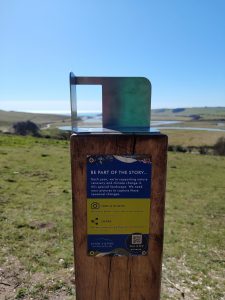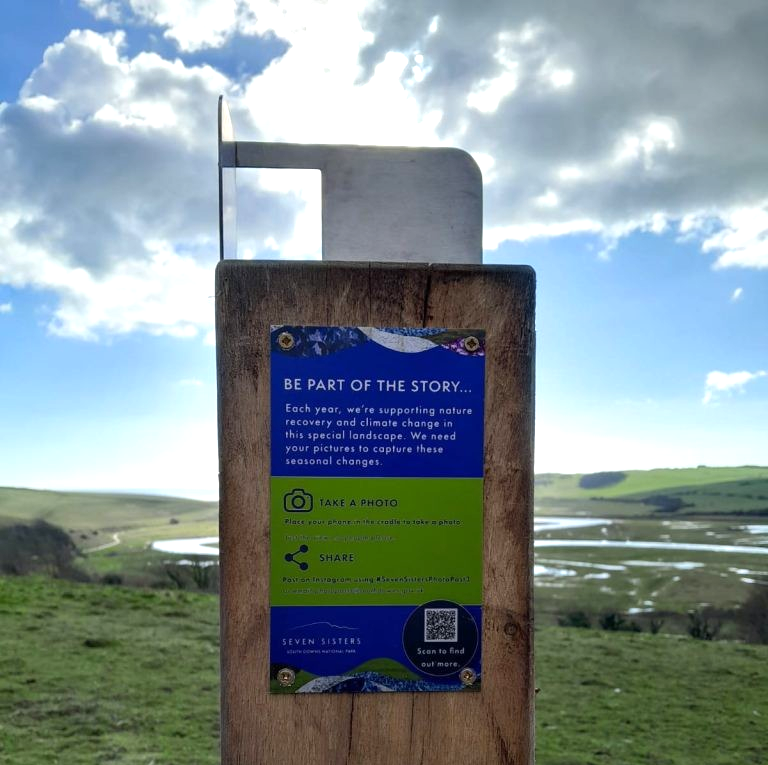Exciting new additions unveiled for spring at Seven Sisters
New “citizen science” photo posts, wildlife ponds and improved habitats for birds are among the latest improvements at Seven Sisters Country Park.
Four years on since the National Park Authority began managing the 280-hectare site and investment continues to improve the iconic beauty spot for both nature and people.
One of the latest upgrades is the installation of three special photo posts. The aim of the posts is to help the National Park Authority create a detailed picture of how its work is changing Seven Sisters across the seasons.

Visitors are being encouraged to become “citizen scientists” by taking a photo using the cradles and submit the image on social media, using the hashtags, or by email. Over time the collated images will be used to build evidence on what’s working at the country park and areas that may need more investment.
Meanwhile, enhancements to wetlands have just been completed, including the restoration of two historic ponds and the creation of a brand-new one in the park’s dry valley. This vital work will help support birds, mammals, amphibians and insects such as dragonflies.
Two important sluice gates have been repaired on the Cuckmere meanders to help control water levels and prevent areas drying out. Two new scrapes, or shallow ponds, have also been dug to create muddy feeding habitats for wading birds such as the little egret, dunlin and ringed plover. Ditches around the meanders have been deepened to prevent predators, such as foxes and badgers, from disturbing groundnesting birds like the redshank.
Other improvements include replacing gates along the South Downs Way, the 100-mile National Trail that runs through the country park.
Claire Onslow, Commercial Manager for Seven Sisters Country Park, said: “This is such a special place and it’s wonderful to see all the changes, big and small, that are making the site even better for wildlife and visitors.
“Everyone can play their part in nature recovery and these new photo posts are a fantastic way of helping in the stewardship of this iconic landscape.
“We’re known for our birdlife and I’m really looking forward to seeing the impact of the improvements and which species find a new home at Seven Sisters!”
The National Park Authority has invested well over £2m in improving visitors facilities over the past four years, including a fully-refurbished visitor centre, a new food-outlet, new toilets, and bins. Last summer saw the unveiling of beautiful holiday cottages and a camping barn for people to be able to enjoy a night under the stars for the first time at Seven Sisters.

Sussex Cattle and Shetland Ponies have been introduced at the site to manage the chalk grassland, called “Europe’s rainforest in miniature” as a single square metre can contain more than 20 butterfly species and up to 40 different wildflowers. The recovery has seen the return of species such as the short-eared owl, starlings and large flocks of dunlin, as well as swathes of colourful wildflower meadows.
For more information about Seven Sisters Country Park visit www.sevensisters.org.uk
Top tips for using the photo posts:
- We only need to see the view – no people please!
- Make sure your camera isn’t zoomed in and you don’t have any filters set.
- Check you’re using the correct hash tag for the location – the plaques have the details.
- If you don’t want to use the social media hashtags, you can simply email us at photoposts@southdowns.gov.uk
- The South Downs National Park was created in 2010 and covers 1,627 km² across Hampshire, West Sussex and East Sussex. Seven Sisters is the first nature site in the National Park to be directly owned and managed by the National Park Authority.
- The Seven Sisters are an amazing geological phenomenon – the chalk being formed under an ancient sea that existed between 65 and 100 million years ago during the age of the dinosaurs. The chalk is the remains of tiny sea creatures that lived in this sea and millions of years of deposits resulted in a huge chalk dome that now covers a vast area across Southern England and Northern France.
- The Seven Sisters represents a fragment of largely unspoilt coastline along a heavily-developed south coast. It was saved from development in 1926 when a group of early environmentalists – including poet Rudyard Kipling, the mother of a dead WWI soldier, a famous pilot and a walking group – led a passionate campaign to oppose the plans. They raised £17,000 – the equivalent of £509,000 today – to buy out the developers and halt construction.

